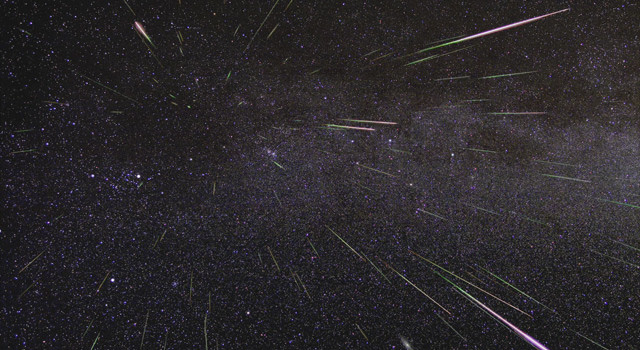[/caption]
Many annual meteor showers have parent bodies identified. For example, the Perseids are ejecta from the comet, Swift-Tuttle and the Leonids from Tempel-Tuttle. Most known parent bodies are active comets, but one exception is the Geminid meteor shower that peaks in mid December. The parent for this shower is 3200 Phaethon. Observations of this object have shown it to be largely inactive pegging it as either a dead comet or an asteroid. But on June 20, 2009, shortly after perihelion, 3200 Phaethon brightened by over two magnitudes indicating this object may not be as dead as previously considered. A new paper considers the causes of the brightening and concludes that it could be a new mechanism leading to what the authors deem a "rock comet".David Jewett and Jing Li of UCLA, the authors of this new paper, consider several potential causes. Due to the size of 3200 Phaethon, they suggest that a collision is unlikely. One clue to the reason for the sudden change in brightness was a close link of a half of a day to a brightening in the solar corona. Given a typical solar wind speed and the distance of 3200 Phaethon at the time, this would put the Geminid parent just at the right range to be feeling the effects of the increase. However, the authors conclude that this cannot be directly responsible by imparting sufficient energy on the surface of the object to cause it to fluoresce due to an insufficient solar wind flux at that distance.
Instead, Jewett and Li consider more indirect explanations. Due to the temperature at 3200 Phaethon's perihelion (0.14 AU) the presence of ices and other volatile gasses frozen solid and then blasting away as often happens in comets was ruled out as they would have been depleted on earlier orbits. However, the blow from the increased solar wind may have been sufficient to blow off loosely bound dust particles. While this is plausible, the authors note that the amount of mass lost if this were the case would be a paltry 2.5 x 10
8
kg. While it's possible that this may have been the cause of this single brightening, this amount of mass loss to the overall stream of particles responsible for the Geminid shower would be insufficient to sustain the stream and similar losses would have to occur ~10 times per orbit of the body. Since this has not been observed, it is unlikely that this event was tied to the production of the meteors. Additionally, it is somewhat unlikely that it could even be the event for this sole case since repeated perihelions would slowly deplete the reservoir of available dust until the body was left with only a bare surface. Unlike active comets which continually free dust to be ejected through sublimation of ice, 3200 Phaethon has no such process. Or does it?
The novel proposition is that this object may have an unusual mechanism by which to continually generate and liberate dust particles of the size of the Geminids. The authors propose that the heating at perihelion causes portions of the rock to decompose. This process is greatly enhanced if the rock has water molecules bonded to it and lab experiments have shown that this can lead to violent fracturing. Such processes, if present, could easily lead to the production of new dust particles that would be liberated during close approach to the sun. This would make this object a "rock comet" in which the properties of a comet's dust ejection via gasses would be carried out by rocks.
To confirm this hypothesis, future observations would be needed to search for subsequent brightening at perihelion. Similarly, it should be expected that such a process may make a faint cometary tail with only a dust component that may be visible as well, although the lack of any such detection so far, despite studies looking for cometary tails, casts some doubt on this process.
 Universe Today
Universe Today
